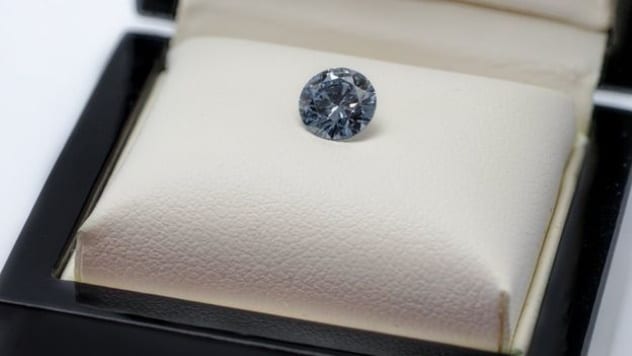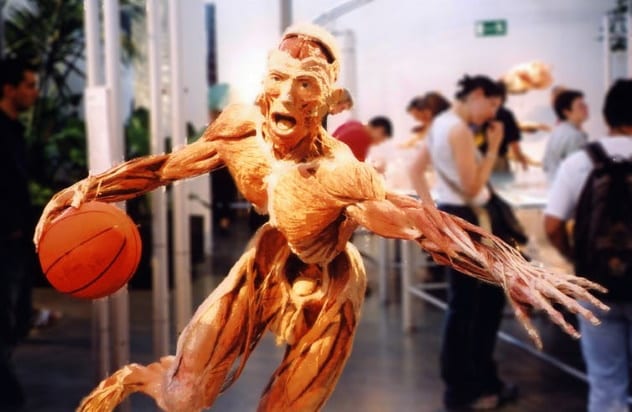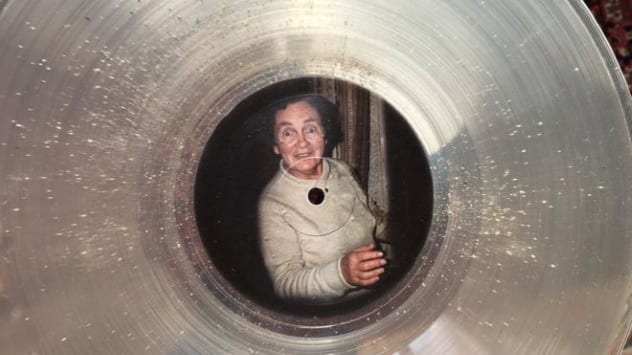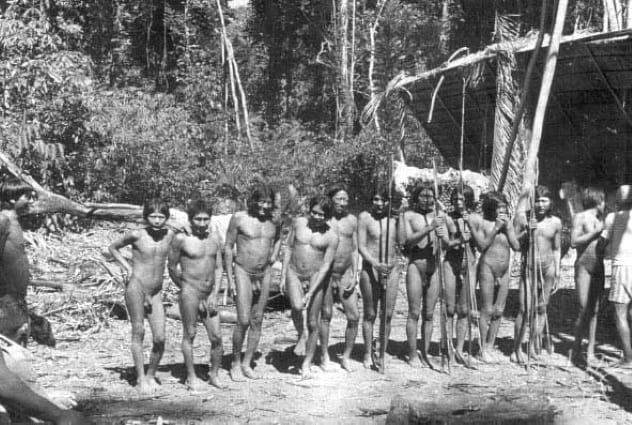 Humans
Humans  Humans
Humans  Movies and TV
Movies and TV The 10 Most Heartwarming Moments in Pixar Films
 Travel
Travel Top 10 Religious Architectural Marvels
 Creepy
Creepy 10 Haunted Places in Alabama
 History
History Top 10 Tragic Facts about England’s 9 Days Queen
 Food
Food 10 Weird Foods Inspired by Your Favorite Movies
 Religion
Religion 10 Mind-Blowing Claims and Messages Hidden in the Bible Code
 Facts
Facts 10 Things You Never Knew about the History of Gambling
 Weird Stuff
Weird Stuff 10 Cool and Creepy Facts about Collecting Tears
 Humans
Humans The Ten Most Lethal Gunslingers of the Old West
 Humans
Humans Ten Historic Men Who Deserve Way More Credit Than They Got
 Movies and TV
Movies and TV The 10 Most Heartwarming Moments in Pixar Films
 Travel
Travel Top 10 Religious Architectural Marvels
Who's Behind Listverse?

Jamie Frater
Head Editor
Jamie founded Listverse due to an insatiable desire to share fascinating, obscure, and bizarre facts. He has been a guest speaker on numerous national radio and television stations and is a five time published author.
More About Us Creepy
Creepy 10 Haunted Places in Alabama
 History
History Top 10 Tragic Facts about England’s 9 Days Queen
 Food
Food 10 Weird Foods Inspired by Your Favorite Movies
 Religion
Religion 10 Mind-Blowing Claims and Messages Hidden in the Bible Code
 Facts
Facts 10 Things You Never Knew about the History of Gambling
 Weird Stuff
Weird Stuff 10 Cool and Creepy Facts about Collecting Tears
 Humans
Humans The Ten Most Lethal Gunslingers of the Old West
Top 10 Ways To Dispose Of Your Body After Death
Death is a solemn, often spiritual occasion, but afterward comes the more mundane problem of what to do with the body. Though burial and cremation remain the most common ways to dispose of a corpse, many people have tried to come up with clean, green, cost-effective, and personal ways to dispose of our mortal remains.
But it’s not always as easy as you may think. No matter what method you try, there always seems to be a bit left over. All the same, if you want to go out in a unique way or for your remains to be put to good use, then you may want to consider the following options.
10 Float Off Into Space

If you always wanted to be an astronaut, you might want to consider spending eternity as a speck of space dust. For around $2,500, you can send your cremated remains into space. For that, you will receive a custom-made “ash capsule” to hold your ashes. The capsule will then be loaded into a satellite and sent off into the cosmos.[1]
There is even an opportunity to have your name engraved on the satellite as a memorial. After the satellite has reached the end of its life circling the planet, it will burn up on re-entry into the Earth’s atmosphere, and your remains will light up the sky as a “shooting star.”
At the moment, however, there is only room on board to take a small portion of your ashes into space. Eventually, it is hoped that technology will allow funeral directors of the future to scatter people’s ashes on the Moon or even fire them into deep space.
If you just fancy a flying visit, however, one company is also offering a service which releases the capsule of ashes with a parachute from the edge of space, so that you can enjoy one last wild ride. Of course, once your remains have landed, your loved ones will be back to square one and will have to figure out what else to do with them.
9 Become A Diamond

The Victorians had a fascination with creating keepsakes from the dead and often designed and wore jewelery made from their loved ones’ hair. Luckily for us, modern science has devised more aesthetically pleasing, and less itchy, mementos. You can become a diamond.
The human body is made up of mostly water, but 18 percent of it is carbon, the same element from which diamonds are made. The diamonds are environmentally friendly since they are not mined and ethical since their creation does not use child laborers, unlike many diamond mines. And unlike a hair brooch, the diamonds can make a shiny necklace.
Carbon is extracted from the created remains and then treated under high heat and pressure, just as if it were being compressed within the Earth. However, this process only takes a few weeks to complete, after which the diamond can be cut and polished.[2]
The resulting diamonds, which have the same structure as mined ones, are often colored blue, due to trace amounts of boron, though they can also come out in other colors. And, just like human beings, all the diamonds have unique characteristics.
8 Sleep With The Fishes
Resomation is a kind of water cremation, which involves dissolving human remains in a water-based alkaline solution. The body is placed in a pressurized vessel containing potassium hydroxide and heated to 152 degrees Celsius (306 °F). After only around three hours, the body is reduced to bones, which are then ground into white powder. The process uses less energy than cremation and produces fewer emissions, so it is good for the environment.[3]
The process of decay is the same as if the body was buried, but the heated, extremely alkaline water speeds up the process so that decomposition which would have much longer can happen in 90 minutes. At the end of the process, the ground-up skeleton is presented to the families, who still have to decide what to do with it.
Burial at sea seems a good option.
7 Be An Ice Cube
If you don’t like getting your feet wet, you could always try promession, or freeze-drying your remains. The proposed method of promession would use liquid nitrogen to freeze-dry your corpse while extracting the water, which comprises 60 percent of our bodies.
Bodies would be frozen at around minus 200 degrees Celsius (–328 °F) so that they become extremely brittle. They would then be vibrated with sound waves until they turn to dust, with the exception of any fillings or surgical implants. The dust would be collected and handed back to the family.[4]
You could put the dust in a biodegradable coffin and bury it so that it turns into compost in around a year. But, then, what do you do with the compost? The problem seems to be never-ending. Ultimately, however, the company that would have offered promession went under before any remains could be promessed.
Drat.
6 Become The Spirit In The Sky

Perhaps we are overthinking this. You could always go low-tech and opt for a Tibetan sky burial. Villagers will carry your body to the sky burial site, usually high up a mountain, while your family stays at home to pray. Then, after some ritual prayers, Tibetan monks and nuns will burn incense and tsampa (a type of roasted flour mixed with butter or milk and a staple food in Tibet), to entice vultures to carry your remains up into the sky.
Your body may be fed to the vultures whole, or, in order to make things easy for the birds, a “body breaker” may chop your remains into pieces. The vultures will gather overhead, and then the monks will stand back, while dozens of birds swarm over the body.
Ideally, the bones will be picked clean, leaving only the skeleton. If the vultures consume everything but the bones, it is taken as a good sign. Conversely, if even the vultures do not want to eat you, it is because you have done evil deeds during your life, and, presumably, that affects the taste.
Sky burials still happen in Tibet, although those who have died from infectious diseases are likely to be cremated instead, for fear of passing the diseases onto the birds. Tibetan Buddhists believe that the body is simply an empty shell that once contained the spirit. Your spirit will already have moved on to a new incarnation, and so, offering the body to vultures is a generous act, giving something back to the Earth.[5]
Once the vultures have departed, the skeleton is often ground to powder and mixed with tsampa. This mixture is given to other birds.
5 Be The Tree

You might decide that, rather than trying to get rid of your remains, you will turn them into something useful. Instead of being buried in a coffin with a gravestone to mark the burial place, you could be interred in a biodegradable “egg” and turn into plant food to nourish a tree. The egg breaks down after burial and provides all the nutrients that a growing sapling needs.
The inventors of the capsules envisage cemeteries of trees rather than gravestones. However, they have encountered resistance in the form of red tape in many countries and can, for the most part, only bury cremated remains in their pods. While these would still provide the soil with some nutrients, it probably wouldn’t be enough to nourish a tree.[6]
4 Be A Dummy

Perhaps you would like your remains to be put to good use. There have always been opportunities to donate your body to medical science, but if you fancy something a little more eye-catching, you could sign up to become one of Gunther von Hagens’s plastinated anatomical figures.
Von Hagens developed a technique to remove all bodily fluids and soluble fats from tissue and replace them with vacuum-forced injections of plastic into the empty tissue cells, so that they harden. Von Hagens had thus invented a way of preserving anatomical specimens so that they could be handled and examined in the open air, rather than peered at through a jar.[7]
Not content with that, however, he set up his own foundation to make exhibits. His models, which are often posed like dummies in a variety of positions, have been exhibited around the world, though not without controversy.
Gunther von Hagens has himself expressed a desire to be plastinated when he dies and has said that he would like to be placed at the entrance to his exhibitions as a kind of macabre greeter. He is not alone. So far, around 17,000 people have signed up to have their remains turned into anatomical studies, including the scientist’s wife and family.
3 Be A Firework

Funerals can be awfully miserable, so what better way than to cheer people up than with a fireworks display? And if you can combine the two, so much the better.
Johnny Depp started a trend when he shot the ashes of his friend, the renegade author Hunter S. Thompson, into the night sky from a gigantic cannon during the finale of a grand memorial fireworks display.
Although Thompson’s funeral was said to have cost millions of dollars, you can now get your remains shot into the sky at a more modest cost. Many funeral companies are offering to fire a portion of your remains up in rockets, or perhaps round and round in a Catherine wheel. Funeral fireworks are becoming increasingly popular, with many people choosing to go out with a bang and make a spectacular exit from their own memorial service.[8]
However, unless you have the financial resources of a mega-star, you are unlikely to get all of your remains into your fireworks. The average rocket will accommodate around a teaspoonful of ash. Even if you fire a rocket for every year of your life, you’re likely to have a fair bit left over.
You could perhaps put the remainder in a sand bucket for people to douse their sparklers.
2 Be A Record

You might consider having yourself made into a vinyl record, which you can have presented to your loved ones after you’re gone. The record could play recordings of you or perhaps a song. (Copyright may be an issue, however.) You can even pay to have a group of musicians create a song with you.
The ashes are added at a late stage of production and can be seen with the naked eye. Again, only about a teaspoonful of ashes are used per record, but you could always give them to your friends and family as a keepsakes.[9]
However, as your ashes are likely to weigh anywhere from between 1.8 to 4.5 kilograms (4–10 lb), you would need to have a lot of friends if you wanted to dispose of all of your remains this way.
1 Be Food For Thought

The term “cannibalism” has always had dark overtones, and those who become cannibals are usually thought to have been motivated by either desperate hunger or perversion. However, in some cultures, “peaceful” cannibalism has been practiced for a long time, and it has been argued recently that overpopulation and scarce food supplies could see the practice spreading in the future.
In the 1980s, Aparecida Vilaca, an anthropologist, studied the phenomenon of cannibalism in the Wari’ people of the Brazilian jungle. They practiced two very different sorts of cannibalism. “Exocannibalism” was the eating of outsiders (captured enemies or strangers who wandered into their midst), and “endocannibalism” was the eating of family members and friends.
Exocannibalism was undertaken in a party-type atmosphere. The meat would be roasted, and the partygoers would “eat with relish.” Endocannibalism, however, was said to be very different. After the death, the whole community would gather for the meal. The cooked meat would be cut into very small pieces by a non-family member and would be eaten with tiny utensils by somber diners.[10]
Endocannibalism has been documented in Australia, South America, and Africa. The practice has been an important part of funeral rituals across the globe at different times. It has even been asserted that some tribes in Borneo used the “secretions” from a corpse as an ingredient in making their rice wine, which was then passed around among the mourners at the funeral and used to toast the dead, although this has not been definitively proven.
Read about more bizarre death practices on 10 Bizarre Funeral Customs From Around The World and 10 Strange And Fascinating Funerals Of Famous People.








